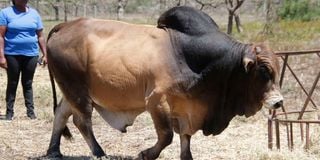Premium
Yes, sexed semen can give bull calves

A Boran bull at Ol Pejeta Conservancy in Laikipia County on September 13, 2023. Males produce millions of sperms that contain either one X or Y chromosome.
Every dairy farmer wishes she could get heifer calves with every birth. The beef farmer yearns for bull calves.
The contrasting preference stems from the utility of the two genders in milk and meat production respectively.
Dairy farmers yearn for heifer calves because they provide them with herd continuity and premium prices to starter farmers and those who need replacement or herd expansion stock.
The high value of dairy heifers led scientists to research techniques for sorting out male and female sperms in the early 80s using rabbits.
Commercial techniques for sorting out heifer calf-producing sperms from those producing bulls for dairy production were developed in 2003.
This resulted in a highly valued and pricey artificial insemination product called sexed semen.
Sexed semen technology is also used in the beef industry to increase the supply of bulls for meat.
The bulls grow and gain weight faster than heifers, their muscles are heavier per unit volume and have less curing loss due to lower water content compared to heifer meat.
Most farmers believe sexed semen means one can only get the desired calf gender after using male or female producing sperms.
A farmer got a rude shock four months ago when his nine out of 10 heifers inseminated with female-sexed semen calved handsome bouncing bulls.
The calves were adorable, confirming the quality of the genetics of the bull and cows that gave rise to them.
But the farmer was mad with the inseminator. He accused the vet doctor of pinching his high value sexed semen and replacing it with ordinary semen.
Fortunately, the vet had kept the empty straws with the farmer and the farmer had actually bought and stored the semen on the farm.
The farmer raised the issue in his WhatsApp group and everyone cried foul.
I was invited to the group to shed some light on the happening.
Some members advised the farmer to sue the vet while others said he should seek compensation from the semen supplier or producer.
I quickly realised there was serious paucity of knowledge in the farmers’ understanding of sexed semen and the nature of the two cells that give rise to the young of mammals, including humans.
My explanation for the happening was lengthy and detailed.
There are two types of cells in the mammalian body. These are the body or somatic cells and the reproductive or germ cells.
The germ cells are two types; the female or egg which is also called the ovum and the male cell or sperm.
In the two types of germ cells, there is genetic material called chromosomes. Chromosomes determine the gender of a mammalian foetus, meaning a heifer or bull, girl or boy are called the X for female and Y for male.
The egg produced by females has X and the sperm produced by males has Y chromosome.
The female produces mainly one egg at a time during the period of heat or oestrus. All eggs contain one X chromosome.
The male on the other hand produces billions of sperms that contain either one X or Y chromosome.
Only one of those sperms is able to pierce the egg and fertilise it to form a zygote that is the beginning of development of a pregnancy, a foetus and eventually a calf in the case of cattle.
Once the lucky sperm enters the ovum, all the others are repelled and die to become reproductive waste.
Thus an X sperm fertilising the egg forms an XX zygote that forms a female foetus and eventually heifer calf.
The Y sperm forms an XY zygote that forms a male foetus and hence male calf. The selection of the X or Y sperm fertilising the egg is by chance and vigour of individual sperms.
Most sexed semen nowadays is sexed up to 99 per cent of the desired gender, meaning that when used in a large population of cattle, there is a one per cent chance that bull calves will be born in female-sexed semen.
The one per cent chance may appear small but when statistical analysis is applied, the reality of getting bulls from female-sexed semen becomes evident.
If one million cows are inseminated with the sexed semen, then there is a chance that 10,000 calves born could be bulls.
If the number was lowered to 100,000 cows inseminated, then 1,000 calves could be bulls.
Errors in statistics are magnified when the test population is small like the 10 heifers the farmer inseminated. I told him all his nine heifers could have been in the one per cent chance to get a bull calf.
The only way to find out if that was the case would be an investigation to determine that the semen was in fact labelled female-sexed and what calf genders a large number of other users of the specific semen had obtained.
I advised against carrying out a large-scale investigation on performance of the semen in a large cross-section of users because of the cost. However, the farmer should investigate to confirm all the straws used were the actual ones he had bought. I also advised him to report the occurrence to the semen supplier and the Kenya Animal Genetics Resource Centre (KAGRC) – the government regulator of semen production and trade.
KAGRC could take up the issue with the semen producer to find out the documented performance of the batch the farmer had used.





